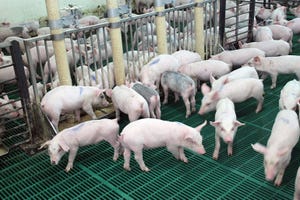This will be a very difficult year for pork producers, outside of a very few that have considerable risk management in place through year-end.

In early March, the pork industry started to ramp up slaughter to build some room in the event that coronavirus impacts would cause a plant go dark or slow. Numbers of pigs processed were higher in the week of March 16 and March 23 by some 150,000 head per week.
At that point, we reached a new all-time high processed number of nearly 503,000 pigs on March 25. Reports available for those weeks indicate that average carcass weights for barrows and gilts remained unchanged at 213 pounds, which is concerning — did we really pull pigs ahead? Cutout values rose in those two weeks by over $10 per hundredweight but have fallen dramatically since.
Falling cutout values for pigs in the last two weeks have been monumental. Wholesale carcass values dropped by $20.94 per hundredweight, or $44.60 per head. Futures prices began their reduction before the week of March 16 and continued to fall until a small recovery last week. The dismal outlook in the futures market remains painful. It provides some evidence that this will be a very difficult year for pork producers, outside of a very few that have considerable risk management in place through year-end.
The disruption in the marketplace, and more specifically the supply chain, is the main cause of the rapid and painful reductions in prices. Moving food distribution from foodservice to retail has had a huge impact on demand. As restaurants have all but closed and most schools are out due to the COVID-19, foodservice processors and product has been mostly idled.
Belly and bacon prices are a prime example. Foodservice makes up as much as 65-70% of all bacon consumption. While many have reported the belly primal driving the cutout over the past few years, the loss of much of the food service sector is evident in drastically falling belly primal values. The major issue is with the preparation and packaging for food service versus the smaller packages for the retail marketplace.
Export markets have been affected as well. Exports of pork in January and February were up 49% from a year ago, with our major markets, except South Korea, all showing gains. Exports to China remained extremely strong, up 680% compared to the prior year. However, we understand that exports to Mexico have slowed as many metro areas have been under stay-at-home requirements. We have seen these effects in the ham primal market in recent weeks.
Opportunities for some relief exist. In early April, the U.S. Small Business Administration came out with a Payroll Protection Program, which included farm business eligibility. Those loans provide low interest financing for payroll costs, eligible for forgiveness if you maintain labor force and cost. It is worth checking out as a small business. There is also talk of some USDA help in the near future, which will be worth watching.
With two harvest plants likely closed the week following Easter, and many others running slower due to employee shortages, this industry is going to experience some challenges. We hope the people who are working in these essential processing roles recover from or avoid contracting this disease and that we as an industry don't see more plants affected.
Source: Kent Bang, who is solely responsible for the information provided, and wholly owns the information. Informa Business Media and all its subsidiaries are not responsible for any of the content contained in this information asset. The opinions of this writer are not necessarily those of Farm Progress/Informa.
About the Author(s)
You May Also Like





